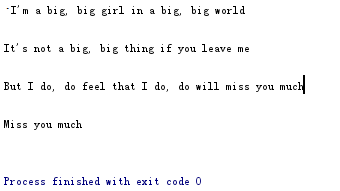字符串操作、文件操作,英文词频统计预处理
1.字符串操作:
- 解析身份证号:生日、性别、出生地等。
- 凯撒密码编码与解码
- 网址观察与批量生成
(1)解析身份证号:
ID = input('请输入十八位身份证号码: ')
if len(ID) == 18:
print("你的身份证号码是 " + ID)
else:
print("错误的身份证号码")
ID_add = ID[0:6]
ID_birth = ID[6:14]
ID_sex = ID[14:17]
ID_check = ID[17]
# ID_add是身份证中的区域代码,如果有一个行政区划代码字典,就可以用获取大致地址#
print("出生地为:"+ID_add)
year = ID_birth[0:4]
moon = ID_birth[4:6]
day = ID_birth[6:8]
print("生日: " + year + '年' + moon + '月' + day + '日')
if int(ID_sex) % 2 == 0:
print('性别:女')
else:
print('性别:男')
# 此部分应为错误判断,如果错误就不应有上面的输出,如何实现?#
W = [7, 9, 10, 5, 8, 4, 2, 1, 6, 3, 7, 9, 10, 5, 8, 4, 2]
ID_num = [18, 17, 16, 15, 14, 13, 12, 11, 10, 9, 8, 7, 6, 5, 4, 3, 2]
ID_CHECK = ['1', '0', 'X', '9', '8', '7', '6', '5', '4', '3', '2']
ID_aXw = 0
for i in range(len(W)):
ID_aXw = ID_aXw + int(ID[i]) * W[i]
ID_Check = ID_aXw % 11
if ID_check == ID_CHECK[ID_Check]:
print('正确的身份证号码')
else:
print('错误的身份证号码')
解析结果:

(2)凯撒密码编码与解码
plaincode=input('letter:')
for i in plaincode:
print(chr(ord(i)+3),end='')
结果:

(3)网址观察与批量生成
for i in range(2,10):
url='http://news.gzcc.cn/html/xiaoyuanxinwen/{}.html'.format(i)
print(url)
打开网址:
import webbrowser as web
url='http://news.gzcc.cn/html/xiaoyuanxinwen/'
web.open_new_tab(url)
for i in range(2,4):
web.open_new_tab('http://news.gzcc.cn/html/xiaoyuanxinwen/'+str(i)+'.html')
网址观察结果:

2.英文词频统计预处理
- 下载一首英文的歌词或文章或小说。
- 将所有大写转换为小写
- 将所有其他做分隔符(,.?!)替换为空格
- 分隔出一个一个的单词
- 并统计单词出现的次数。
代码:
str='''I'm a big, big girl in a big, big world
It's not a big, big thing if you leave me
But I do, do feel that I do, do will miss you much
Miss you much '''
str=str.lower()
s=',.!?'
for c in s:
str = str.replace(c, "")
print(str.split())
print(str.count('big'))
结果:

3.文件操作
- 同一目录、绝对路径、相对路径
- 凯撒密码:从文件读入密函,进行加密或解密,保存到文件。
- 词频统计:下载一首英文的歌词或文章或小说,保存为utf8文件。从文件读入文本进行处理。
同一目录读文件代码:
f=open('yw.txt','r',encoding='utf8')
text=f.read()
f.close()
print(text)
绝对路径读文件代码:
f=open(r'C:\Users\Administrator\PycharmProjects\bd\venv\lj\xd.txt','r',encoding='utf8') text=f.read() f.close() print(text)
相对路径读文件代码:
f=open(r'..\venv\lj\xd.txt','r',encoding='utf8') text=f.read() f.close() print(text)
读取文件内容结果:

凯撒密码:
file=open("caesar.txt")
caesar=file.read()
print("加密前的密码:",caesar)
cipher='';
jiemi='';
for i in caesar:
cipher=cipher+chr(ord(i)+3);
print("加密后的密码:",cipher)
file=open("cipher.txt",'w')
file.write(cipher)
file.close()
加密结果:

加密前文件:

加密后文件:

4.函数定义
- 加密函数
-
def get_text(): plaincode = 'abcd' cipher='' for i in plaincode: cipher=cipher+chr(ord(i) + 3) return cipher bigstr = get_text() print(bigstr) - 解密函数
-
def get_text(): plaincode = 'defg' cipher='' for i in plaincode: cipher=cipher+chr(ord(i) -3) return cipher bigstr = get_text() print(bigstr) - 读文本函数
-
def get_text(): with open('yw.txt', 'r', encoding='utf8',errors='ignore') as f: text = f.read() return text bigstr = get_text() print(bigstr)




